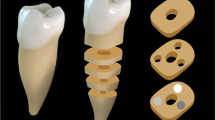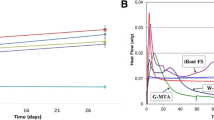Abstract
Objectives
The aim of this study was to evaluate the sealing ability and morphological microstructure of Biodentine in comparison to ProRoot mineral trioxide aggregate (MTA) after storage in an acidic environment.
Materials and methods
Biodentine and ProRoot MTA were prepared and packed into the canal lumen of dentin disks. Twenty specimens of each material were further randomly divided into two groups according to the storage media: group A: materials with saline as storage medium; group B: materials with citric acid buffered at pH 5.4 as storage medium. The sealing ability was evaluated at 1, 3, 6, and 24 h and 1 or 3 months, using a fluid transport model for quantitative analysis of endodontic microleakage. The morphological microstructures of the materials were also evaluated using scanning electron microscopy.
Results
During the first 24 h, MTA showed greater fluid transport values than Biodentine in both environments. At the 3-month measurement, when the materials were stored in saline, MTA showed greater ability to prevent fluid movement than Biodentine (p < 0.0001). However, when the materials were stored in an acidic environment, no statistical significant difference was found after 3 months. After storage in saline, both materials showed an uneven crystalline surface with similar hexagonal crystals. The microstructure of Biodentine changed after exposure to citric acid, showing a relatively smooth surface with more spheroidal crystals.
Conclusions
The exposure to an acidic environment, within the limits of this study, seems to result in morphological changes of Biodentine in a different manner than MTA. MTA shows good ability to prevent fluid movement over time, in both environments. The ability of Biodentine to prevent fluid movement over time was enhanced in the acidic environment.
Clinical relevance
The findings of the present study could imply that both materials are indicated for use in an acidic environment.

Similar content being viewed by others
References
Parirokh M, Torabinejad M (2010) Mineral trioxide aggregate: a comprehensive literature review—part I: chemical, physical, and antibacterial properties. J Endod 36:16–27
Torabinejad M, Parirokh M (2010) Mineral trioxide aggregate: a comprehensive literature review—part II: leakage and biocompatibility investigations. J Endod 36:190–202
Lee SJ, Monsef M, Torabinejad M (1993) Sealing ability of a mineral trioxide aggregate for repair of lateral root perforations. J Endod 19:541–544
Aeinehchi M, Eslami B, Ghanbariha M, Saffar AS (2003) Mineral trioxide aggregate (MTA) and calcium hydroxide as pulp-capping agents in human teeth: a preliminary report. Int Endod J 36:225–231
Nair PN, Duncan HF, Pitt Ford TR, Luder HU (2008) Histological, ultrastructural and quantitative investigations on the response of healthy human pulps to experimental capping with mineral trioxide aggregate: a randomized controlled trial. Int Endod J 41:128–150
Torabinejad M, Watson TF, Pitt Ford TR (1993) Sealing ability of a mineral trioxide aggregate when used as a root end filling material. J Endod 19:591–595
Pace R, Giuliani V, Pini Prato L, Baccetti T, Pagavino G (2007) Apical plug technique using mineral trioxide aggregate: results from a case series. Int Endod J 40:478–484
Simon S, Rilliard F, Berdal A, Machtou P (2007) The use of mineral trioxide aggregate in one-visit apexification treatment: a prospective study. Int Endod J 40:186–197
Gandolfi MG, Iacono F, Pirani C, Prati C (2012) The use of calcium-silicate cements to reduce dentine permeability. Arch Oral Biol 57:1054–1061
Huang GT (2009) Apexification: the beginning of its end. Int Endod J 42:855–866
Kontakiotis EG, Filippatos CG, Tzanetakis GN, Agrafioti A (2015) Regenerative endodontic therapy: a data analysis of clinical protocols. J Endod 41:146–154
Ber BS, Hatton JF, Stewart GP (2007) Chemical modification of ProRoot MTA to improve handling characteristics and decrease setting time. J Endod 33:1231–1234
Prati C, Gandolfi MG (2015) Calcium silicate bioactive cements: biological perspectives and clinical applications. Dent Mater 31:351–370
Laurent P, Camps J, De Méo M, Déjou J, About I (2008) Induction of specific cell responses to a Ca(3)SiO(5)-based posterior restorative material. Dent Mater 24:1486–1494
Ng YL, Mann V, Rahbaran S, Lewsey J, Gulabivala K (2008) Outcome of primary root canal treatment: systematic review of the literature—part 2. Influence of clinical factors. Int Endod J 41:6–31
Bates CF, Carnes DL, del Rio CE (1996) Longitudinal sealing ability of mineral trioxide aggregate as a root-end filling material. J Endod 22:575–578
Yatsushiro JD, Baumgartner JC, Tinkle JS (1998) Longitudinal study of the microleakage of two root-end filling materials using a fluid conductive system. J Endod 24:716–719
Wu MK, Kontakiotis EG, Wesselink PR (1998) Long-term seal provided by some root-end filling materials. J Endod 24:557–560
Aqrabawi J (2000) Sealing ability of amalgam, super EBA cement, and MTA when used as retrograde filling materials. Braz Dent J 188:266–268
Roy CO, Heansonne BG, Gerrets TF (2010) Effect of an acid environment on leakage of root-end filling materials. J Endod 27:7–8
Davis JL, Jeansonne BG, Davenport WD, Gardiner D (2003) The effect of irrigation with doxycycline or citric acid on leakage and osseous would healing. J Endod 29:31–35
Tay KC, Loushine BA, Oxford C, Kapur R, Primus CM, Gutmann JL, Loushine RJ, Pashley DH, Tay FR (2007) In vitro evaluation of a ceramicrete-based root-end filling material. J Endod 33:1438–1443
Yildirim T, Oruçoğlu H, Cobankara FK (2008) Long-term evaluation of the influence of smear layer on the apical sealing ability of MTA. J Endod 34:1537–1540
Camilleri J, Gandolfi MG, Siboni F, Prati C (2011) Dynamic sealing ability of MTA root canal sealer. Int Endod J 44:9–20
Francisconi LF, Honório HM, Rios D, Magalhães AC, Machado MA, Buzalaf MA (2008) Effect of erosive pH cycling on different restorative materials and on enamel restored with these materials. Oper Dent 33:203–208
Formosa LM, Mallia B, Bull T, Camilleri J (2012) The microstructure and surface morphology of radiopaque tricalcium silicate cement exposed to different curing conditions. Dent Mater 28:584–595
Hashem AA, Wanees Amin SA (2012) The effect of acidity on dislodgment resistance of mineral trioxide aggregate and bioaggregate in furcation perforations: an in vitro comparative study. J Endod 38:245–249
Camilleri J, Pitt Ford TR (2006) Mineral trioxide aggregate: a review of the constituents and biological properties of the material. Int Endod J 39:747–754
Watts JD, Holt DM, Beeson TJ, Kirkpatrick TC, Rutledge RE (2007) Effects of pH and mixing agents on the temporal setting of tooth-colored and gray mineral trioxide aggregate. J Endod 33:970–973
Namazikhah MS, Nekoofar MH, Sheykhrezae MS et al (2008) The effect of pH on surface hardness and microstructure of mineral trioxide aggregate. Int Endod J 41:108–116
Saghiri MA, Lotfi M, Saghiri AM et al (2008) Effect of pH on sealing ability of white mineral trioxide aggregate as a root-end filling material. J Endod 34:1226–1229
Smith JB, Loushine RJ, Weller RN et al (2007) Metrologic evaluation of the surface of white MTA after the use of two endodontic irrigants. J Endod 33:463–467
Elnaghy AM (2014) Influence of acidic environment on properties of biodentine and white mineral trioxide aggregate: a comparative study. J Endod 40:953–957
Malamed SF (2004) Handbook of local anesthesia, 5th edn. Mosby, St. Louis
Reis AF, Giannini M, Kavaguchi A, Soares CJ, Line SR (2004) Comparison of microtensile bond strength to enamel and dentin of human, bovine, and porcine teeth. J Adhes Dent 2:117–121
Sarkar NK, Caicedo R, Ritwik P et al (2005) Physicochemical basis of the biologic properties of mineral trioxide aggregate. J Endod 31:97–100
Qu H, Wei M (2008) The effect of temperature and initial pH on biomimetic apatite coating. J Biomed Mater Res B Appl Biomater 87:204–212
Shokouhinejad N, Nekoofar MH, Iravani A, Kharrazifard MJ, Dummer PM (2010) Effect of acidic environment on the push-out bond strength of mineral trioxide aggregate. J Endod 36:871–874
Lee YL, Lee BS, Lin FH, Yun Lin A, Lan WH, Lin CP (2004) Effects of physiological environments on the hydration behavior of mineral trioxide aggregate. Biomaterials 25:787–793
Taylor HFW (1997) Cement chemistry, 2nd edn. Thomas Telford Ltd, London
Acknowledgments
The authors would like to greatly acknowledge Dr. Hagay Shemesh (Chair, Division of Endodontology, Academic Centre for Dentistry Amsterdam (ACTA), the Netherlands) for his critical comments that greatly improved the manuscript.
Author information
Authors and Affiliations
Corresponding author
Ethics declarations
Conflict of interest
The authors declare that they have no competing interests.
Ethical approval
This article does not contain any studies with human participants or animals performed by any of the authors.
Rights and permissions
About this article
Cite this article
Agrafioti, A., Tzimpoulas, N., Chatzitheodoridis, E. et al. Comparative evaluation of sealing ability and microstructure of MTA and Biodentine after exposure to different environments. Clin Oral Invest 20, 1535–1540 (2016). https://doi.org/10.1007/s00784-015-1638-6
Received:
Accepted:
Published:
Issue Date:
DOI: https://doi.org/10.1007/s00784-015-1638-6




